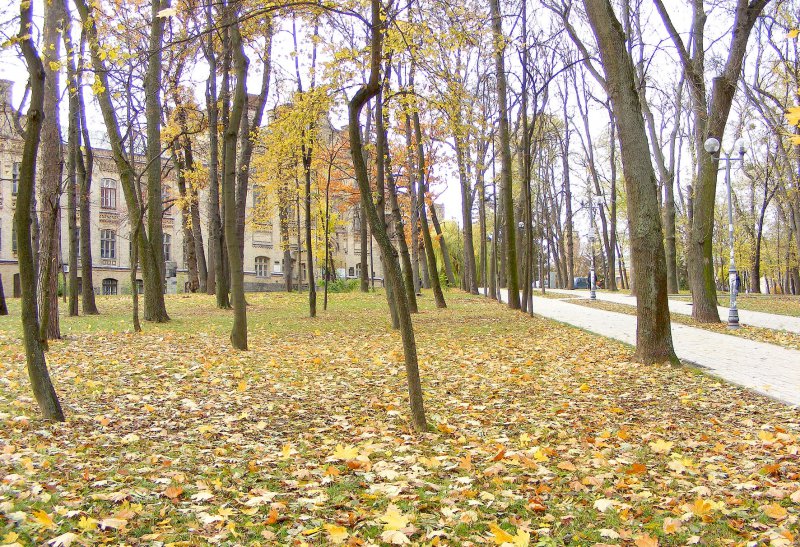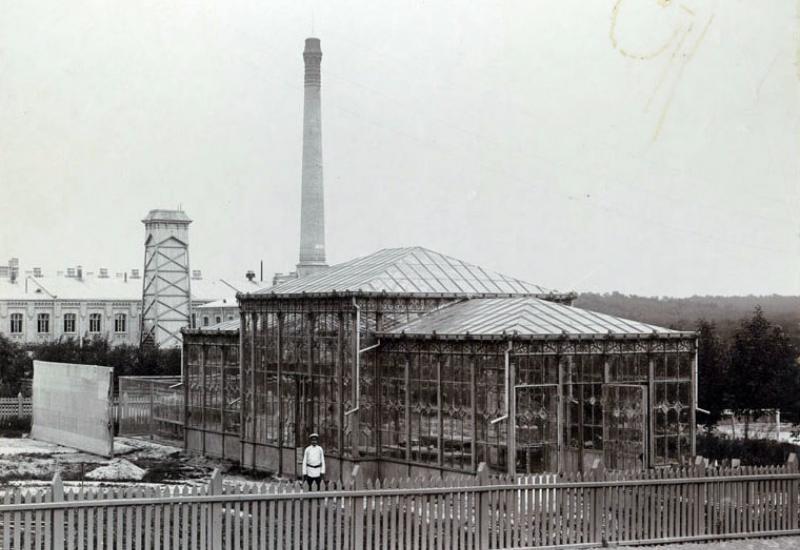Every morning, metro trains bring thousands and thousands of passengers to the Politekhnichnyi Instytut station. For most of them, the institute, or, more precisely, the university - the National Technical University of Ukraine “Igor Sikorsky Kyiv Polytechnic Institute'' - is the place of their study or work. For many, once it was the place of study, but now it is work. People come here not only by metro, but also by trolleybuses, trams and shuttle buses - Igor Sikorsky Kyiv Polytechnic Institute has really favourable location: it is easy to get here from any part of the city, and this adds to its attractiveness in the eyes of students. People stream under the green arches of the old park and split up along the parkways that lead to the university buildings. The way is familiar, so those who make it every day are not at all surprised that the main centre of technical science and education of Ukraine does not begin with strict functional buildings, as it would seem appropriate for such a serious institution, but with a picturesque green massif. However, for prospective students and their parents, who got to Kyiv for the first time, such an entrance to the university of their dream is a surprise. It is all the more pleasant that this natural barrier protects the territory of the Igor Sikorsky Kyiv Polytechnic Institute from the noise and exhaust gases of one of the main highways of Kyiv quite well.
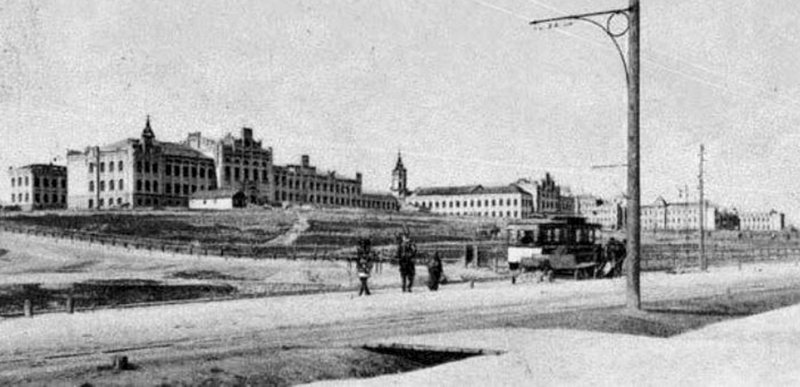
A little time passes, and another folk fills the parkways. Mothers with children, pensioners and jogging lovers predominate among them. Actually, athletes of various levels of training are here from the very morning until late in the evening, but students run mostly in the morning and in the evening: their day obviously complies with the schedule of classes. The park is never empty even in winter - when there is snow, not only children but also adults like to run here on skis. What's more, skiing competitions are even held here sometimes!
It is worth noting that, in addition to the residents of the surrounding streets, residents of Kyiv also come here from other districts of the city - thanks to the convenient location of the university, this is easy to do. In a word, Polytechnic Park is a well-known place and popular among the citizens.
It is really beautiful, because real experts in their field were involved in its creation. That was not yesterday, but more than a hundred and ten years ago, because the park is the same age as the university and was created as an integral part of it.
Therefore, it is impossible to talk about it without at least passing reference to the history of this educational institution established in Kyiv.
Miner Field
The problem of training its own engineering personnel was extremely acute for Ukraine, or the South-Western Territory, as our land was then called in official documents at the end of the 19th century. The Kharkiv Practical Technological Institute only trained specialists on the territory of sub-russian Ukraine before 1898. Truth be told, departments of technology that trained engineers existed at the universities of Kyiv, Kharkiv and Odesa, but that was not enough. Therefore, the issue of opening new higher technical educational institutions in the largest industrial centres of the region was brought up by representatives of local business circles at any opportunity. The Kyiv merchants (that's what entrepreneurs were called then) were especially persistent in this matter. It was not surprising: Kyiv at that time became the real capital of sugar manufacturing, sugar trade and flour industry. It was connected with other regions of the country by a network of transport corridors - the South-Western, Moscow-Kyiv-Voronezh, Poltava, and Kovel railways intersected here. Kyiv's transport capabilities were successfully complemented by its location on the bank of the main water transport corridor of the region - the Dnipro. Therefore, machine-building enterprises popped up like mushrooms after the rain here. Qualified technicians were a crying need. Thus, talks about the establishment of an educational institution for their training in the city had been going on since the 80s of the 19th century. However, they only got the practical effect at the end of the nineties of the 19th century, after the Kyiv authorities, in the person of the then head of the City Duma Stepan Solskyi, and the state authorities, represented by the then Finance Minister of imperial russia Sergei Witte, joined the case.
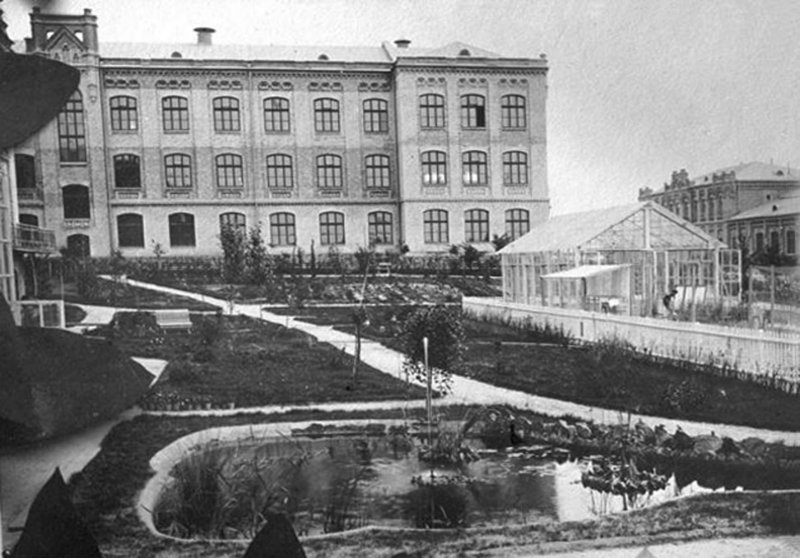
We will not give full details of the way in which the extremely important matter of financing the new educational institution was resolved, you can learn about it from sources devoted to the history of higher education in Ukraine, and books and articles on the history of the Igor Sikorsky Kyiv Polytechnic Institute. Let's just note that the money for its creation came both from benefactors, primarily Kyiv entrepreneurs and their associations, and from the state and city budgets. In addition, in order to provide financial support for the new educational institution, the Kyiv City Duma issued 5 percent loan bonds in 1898 for a total of 300,000 roubles maturing in 1965.
The organisers did not immediately decide on the location of the future institute. Initially, plots on Pechersk (in Laboratornaya St.), on Batyieva Hora, in Lukianivka, and others were considered. However, after carefully weighing all pros and cons, the Committee for the Polytechnic Institute Establishment decided to place the new institution in Shuliavka, along the Brest-Litovsk highway.
This plot was 38 acres in area and belonged to the military department. It was an abandoned field for military exercises, or, as it was also called, Miner Field (Ukr. – Saperne Pole), with two sand hills in the middle, numerous pits, and without any signs of bushes or trees. It was separated from the present Prospect Peremohy by a ditch with a depth of more than 2 metres in some places. In return, the military received a plot of government land in another location that was twice as large.
At the end of November 1897, the Polytechnic Institute architectural design competition was announced "...with an agreement to pay 1,000 Karbovanets for each submitted project and, on top of that, 4,000 Karbovanets to the author of the project recognized best after correction it in accordance with the comments received." As soon as in March of the following year, the commission made a decision on the winner of the competition. The design of the famous St. Petersburg architect I.S. Kitner was recognized as the best of the eight projects presented. The project was submitted under the eloquent slogan "Prestissimo" ("Very quickly"), and indeed, the pace of its realisation was extremely high: earthwork operations began in May, and in the following September, 1899, the first institute buildings were consecrated. Namely the buildings, not a separate building, since the institute, following the example of the best European universities, was designed as an educational and scientific complex, a kind of town with educational and industrial buildings, residential buildings, experimental plots, a pond, a botanical garden (or, more precisely, a small arboretum) and even its own park with an area of approximately 14.5 hectares. Everything was aimed at implementing the idea of polytechnic education, the task of which was not only the accumulation of a certain amount of knowledge by future specialists, but also the formation of independent activity skills in them. For this, students had the opportunity not only to listen to lectures, but also to work in laboratories, job training workshops, at the instructional farm with an experimental field and a fold, as well as in a botanical garden and a park. That is, they could immediately reinforce theoretical knowledge with practical work.
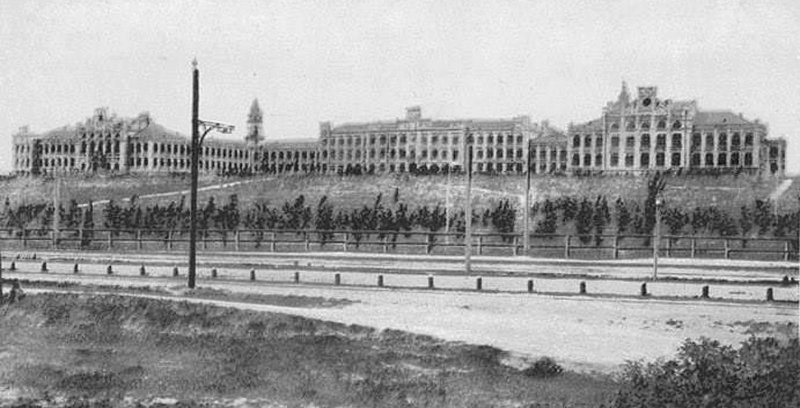
The birth of the park
The botanical garden and the park became a place for acquiring new skills for students of the agricultural department in addition to laboratories, experimental fields, a fold, etc. However, shortly after the start of the institute operation, they were removed from the subordination of the Department of Botany, which, according to its first head, the famous scientist Professor Evhen Votchal, should have been exempted from what was not related to its direct duties, i.e., only teaching and scientific work. However, at the same time, the students of the agricultural department had a number of practical classes in the botanical garden and park.
Truth be told, such an opportunity did not appear immediately after the start of the institute work. The plants did not grow well here due to the nature of the soil and topography of the area allocated for the institute: without proper care, the trees simply did not take root there. As Viktor Kyrpychov, the first rector of the Kyiv Polytechnic Institute, recalled in 1913, the territory allocated for the institute resembled a desert. Not only did trees or bushes not grow there, but not a single blade of grass. All of the territory was cratered, there were traces of mobile kitchen trailers, messing facilities, and tents all around. On August 30, 1898, on the day of the laying the foundation stone of the Kyiv Polytechnic Institute, it was hot, a strong wind raised clouds of dust and sand, and that enhanced the similarity of this area with a desert even more.
The Park was planned in 1901, and the same year the mass importation of seedlings began. Truth be told, the first trees were planted here a little earlier - in the fall of 1900. They were plants from the Botanical Garden of the St. Volodymyr University, the institute paid 69 roubles 75 kopecks for them, and 100 Lombardy poplars from the well-known Kyiv nursery of E. Christer for 20 roubles in total. At the meeting on February 28, 1901, the Kyiv Polytechnic Institute administration decided to do planting within three years. However, planting was also carried out in the following years: for example, 200 trees were planted there in 1912. Soon, 2,300 Siberian pea-tree seedlings appeared in the park from the gardener I. Kaharlytskyi, as well as new arrivals from the nursery of E. Christer, and other plants. The horticulturist E.I. Blekte, who supervised all works in it and planned plantings, was tasked with taking care of the park. From that time to the revolution of 1917, maintenance of the park and salaries of the staff - gardeners and workers - cost the institute 1000-1200 roubles annually.
As soon as April 1902, the administration of the institute accepted from the Building Commission "a planned, surrounded by a temporary fence and equipped with roads, sidewalks and electric lights, the estate of the Institute with an area of 38 arpents with a park arranged on it..." Although the main works in the park were finished, it needed additional arrangement - getting the paths into shape, installing benches, arranging flower beds, etc. So, the work in it continued.
According to the cost estimate, 49143 roubles 48 kopecks were allocated for the construction of the park. The planning was based on a regular principle, that is, a so-called French park was created where the pattern of avenues, paths and flower beds with green plantings has the correct geometric shape. The parkway's length was to be approximately 1,500 sazhens, i.e., more than 3 kilometres.
Park avenues lined with trees and shrubs connected the nearest streets with educational and residential areas. Some of them are extant and even now have a quite satisfactory condition. These are an ash avenue in the eastern part of the park, a linden avenue from academic building 35, where the Educational and Research Institute for Applied System Analysis of the Igor Sikorsky Kyiv Polytechnic Institute is situated, to Prospect Peremohy, an oak avenue in the southern part of the park, chestnut avenues towards Prospect Peremohy and near the academic building 1. Close plantings near the prospect gradually turned into a landscape of semi-open and open spaces at the buildings. This made it possible to combine decorative trees and shrubs naturally, and balance them with architectural structures, which created picturesque views of the university. Distinct groups stood out among the variety of trees: pine and larch groves, spruces, avenues of lilac and mock orange.
Most of the plants were planted according to the type of forest crops, that is, seedlings aged 2-5 years. Seedlings were brought from the Fastiv forestry: black locust, silver maple, elm, common oak, ash, small-leaved linden, Norway maple, pine, birch, spruce. The rarest ones, as already mentioned above, were provided by the Botanical Garden of St. Volodymyr Kyiv University.
It is worth noting that the park grew alongside with the new buildings and residential buildings of the institute, so the entire territory of the campus became, in fact, one large woodland, despite the fact that the territory of the park, in fact, was limited by a wide strip of vegetation that stretched along the Brest-Litovsk highway. However, at the buildings, the park almost imperceptibly turned into a botanical garden (arboretum), which was managed by Professor Votchal, and its sections with greenhouses and a swimming pool, located behind the main academic building 1, served purely educational and scientific purposes. By the way, the mentioned pool with a fountain and an underwater grotto existed for a long time and was only covered with sod in the second half of the last century, during the redesign of the institute territory. And the trees that were planted in the morning of its life decorate the campus even now.
This is quite rare, the oldest Gingko biloba in Kyiv (another specimen of such a tree, which was in the collection of the Botanical Garden of Taras Shevchenko University, was dug up and taken to Germany by the Germans during their retreat from Kyiv in 1943). Scientists consider Ginkgo biloba to be the oldest of all trees growing on Earth today. It can be seen near the Art and Culture Center of the Igor Sikorsky Kyiv Polytechnic Institute; it is surrounded by a low fence.
This is also the Kentucky mahogany, also known as American coffee berry or nickar tree, which has not yet been fully studied by scientists and is extremely interesting due to the many valuable properties of its fruit, which, however, should be handled with care due to the presence of poisonous cytosine in them.
This is the Manchurian walnut, which is exotic for our country, besides its rare beauty, it is also known for the fact that everything in it is useful for people - from the bark and light, hard and beautiful brown wood to nuts and leaves, which emit healing phytoncides in the warm season.
This is the mysterious Cotinus, which is also called the smoke bush or sumac, which hides its beauty until late autumn, and in October explodes with all the colours of the warm part of the solar spectrum. Two old shrubs grow on the lawn in front of the main university building and allow nobody to stay indifferent.
This is also... However, there are so many rare and interesting species in the park and on the campus of the Igor Sikorsky Kyiv Polytechnic Institute that in order to list them and their properties, not an essay is needed, but a whole book. By the way, the KPI Park is considered one of the richest parks in Kyiv in terms of the number of tree and shrub species - there are more than a hundred of them.
For some time, the park was open to the public. Actually, the same as the entire territory of the institute. New buildings with valuable equipment, neat residential buildings for lecturers and employees, and rare plantings in the park and botanical garden began to attract thieves from all over Kyiv. The location of the Kyiv Polytechnic Institute also contributed to that - in those days, Shuliavka was a distant suburb. So, the institute was forced to protect its property and territory.
Since the budget for the construction of the institute campus did not include funds for a fence, initially a temporary wooden fence was built around the institute estate with a park with the money intended for the repair and maintenance of the premises. However, that fence did not fully perform its functions. In addition, it collapsed soon and required frequent repairs. A capital fence on stone masonry with a facade along the line of the Brest-Litovsk highway was needed. It was built and stood until the beginning of the seventies of the 20th century.
However, the fence did not solve the problem. In the end, free access to the park was prohibited. In 1912, a fee of 1 ruble was set for the visit, which was quite high for those times. Only employees of the institute, students, their relatives and persons recommended by the administration could enter the park free of charge. Therefore, the number of vandals on its territory immediately decreased. However, the institute did not receive much money: only 400 tickets were sold in 1912. Access to the park was paid for in subsequent years as well, which allowed not only to preserve the park's vegetation, but also to care for it properly.
Material evidence of wars and revolutions
The cataclysms of the revolution and the civil war could not fail to affect the Kyiv Polytechnic Institute. They also left behind material evidence. These are traces of cannon and rifle shots on the sidewall of the academic building 4, where the Faculty of Chemical Technology has been located since the establishment. These cracks can only be seen on one of its side walls - the one closer to the building 1, and they are clearly visible from the campus park avenue. It is worth mentioning that the entire wall was shelled, because there are bricks knocked out or mutilated by shells, bullets or buckshot not only on its blind part, but also between the windows.
Whose bullets left such cracks on the wall, who exactly and when fought here, is not known for sure.
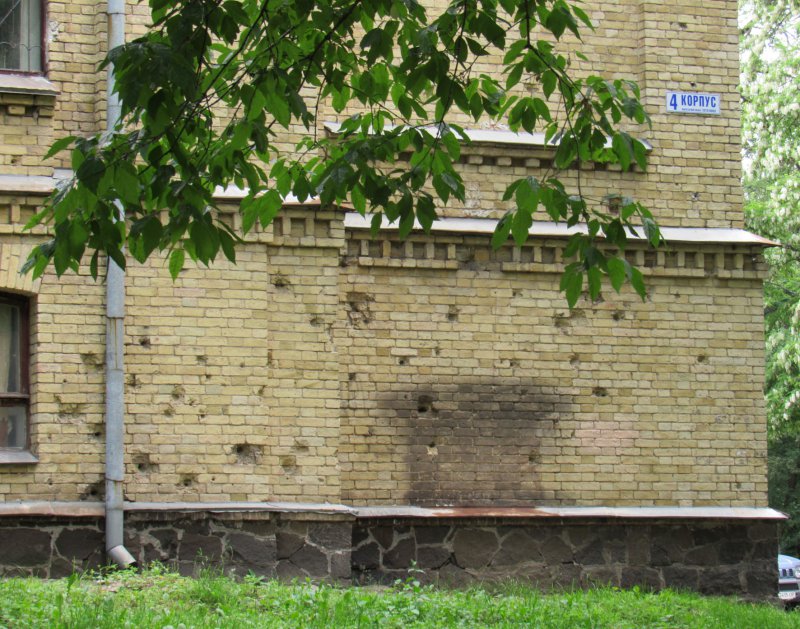
It is possible that these are evidence of fierce battles for Kyiv in November 1943. As you know, the tanks of the 38th Army of the 1st Ukrainian Front were the first to enter the capital of Ukraine from Zhytomyr. They arrived hotfoot on the battlefield on the Brest-Litovsk Highway, as Prospect Peremohy was then called. Nykyfor Sholudenko, starshyna of the Guards, the commander of the first tank that broke into Kyiv, was killed in the area of the Bilshovyk plant. Therefore, it is possible that the broken bricks on the walls of the academic building 4 of the Igor Sikorsky Kyiv Polytechnic Institute are the traces of the German defence, because their location indicates that the fire was directed towards the highway. However, it has not yet been possible to find any arguments in support of this version or its refutation.
The assumption was first expressed in a conversation with the author by Viktor Lazarenko, the head of the Technology in Education Office of the Department of Educational Work of the Igor Sikorsky Kyiv Polytechnic Institute. In his opinion, these marks could have appeared on December 14, 1918, when the regime of Hetman Skoropadskyi was replaced by the Directorate and Symon Petliura's troops entered the city. That is, during the battle, which was described in the novel "The White Guard" by the outstanding writer, a native of Kyiv, Mikhail Bulgakov. Those who have flipped through the pages of this book at least once have probably not forgotten this place:
"...horses appeared like dots, shrapnel began to burst with a high cranelike sound in a thick sky that promised snow. Horse dots gathered in a rank and, having seized the entire width of the highway, began to swell, blacken, increase in size and rolled to Nai-Turs. Shutter sound echoed along the cadet lines, Nai took out his whistle, whistled shrilly and shouted:
- Right on the cavalry!.. in salvoes… commence firing!
The spark passed through the grey formation of lines, and cadets sent the first salvo to Kozyr. A roll of cloth was torn right from the sky to the walls of the Polytechnic Institute three times after that, and the Nai-Turs’s battalion fired three times, and reverberating peals of thunder echoed. Black ranks of horses broke in the distance, parted and disappeared from the highway.``
Note that Mikhail Bulgakov wrote a novel, not a chronicle of events. And the battle in which the cadets under the command of Colonel Nai-Turs took part was, in fact, only one of the combat episodes, because the real scale of the conflict was wider than in the book. By the way, in the passage quoted above, the answer to the question why the wall has holes from shots not only from rifles but also from guns, is also given - pay attention to the mention of shrapnel bursts. And those guns could stand not only in the highway, but also in the side streets and avenues of the institute estate. And the aggressors could not only attack the cadets from the front, but also try to bypass them from the flanks. They, in their turn, struggled to stop them. So, given how carefully the writer treated the details in this, perhaps one of the most Kyiv works in the entire world literature, with which accuracy he depicted the historical background, we can safely assume that everything in life happened as it was written in a book.
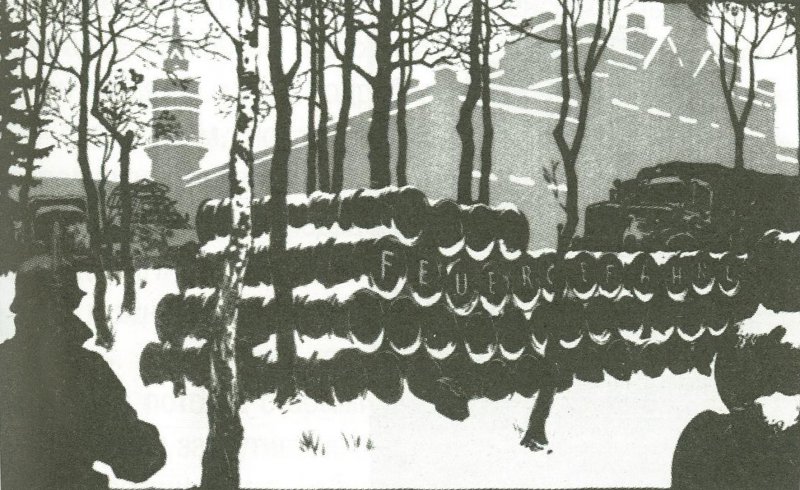
It is certain that the trees in the park must have been damaged during that fight. However, nature heals such wounds quickly, and we cannot see them today. And the residents of the surrounding streets simply picked up broken branches and trees for fuel because times were very difficult...
The post-revolutionary years were not favourable to the institute park. But even the fact that it survived and was not cut for firewood – that was a mercy. However, there were almost no careful gardeners left at the institute - there simply weren't enough funds to support them. The administration and workers took care of the development of the park to the best of their knowledge and belief in beauty, therefore, although it did not decline, it gradually became wild. Especially after a separate educational institution was created on the basis of the agricultural faculty of the Kyiv Polytechnic Institute, which was transferred from Shuliavka to Holosiiv together with the entire teaching staff, auxiliary staff and students.
Peace, war, and again peace
Certainly, the park became public again. Gradually, planting new trees and shrubs only during mass subbotniks (voluntary unpaid work on days off), without taking into account the initial plan of spatial solutions became customary. Some plantations, too many of those that needed special care, died, and other rare trees developed diseases. Carefully planned lawns were overgrown with self-seeding. By the 1940s, only the remains of some avenues planted with shrubs and trees of the same species were more or less preserved in the park. At the same time, it was cleaned of dead standing trees and garbage regularly, and it would be unfair to claim that the park was neglected.
During the occupation of Kyiv in the Second World War, the Germans placed a military hospital in the two oldest buildings of the Igor Sikorsky Kyiv Polytechnic Institute - the main (now academic building 1) and of the Chemical Department (now academic building 4). However, former dwellers who were not evacuated for one reason or another, were allowed to live in their houses located on the institute territory. The entrance to the territory, as well as the entrance to the park, remained free. It was all the stranger that a little below the right wing of the main building, just in the park, using it as a natural masking, the invaders arranged a gas storage facility. It was not an oil depot with tanks dug into the ground and separate structures for oil storage, but simply long stacks of barrels with gasoline, which made that place especially dangerous. If the Soviet aviation, which made raids on the occupied Kyiv from time to time, dropped bombs on that storage, the fire would certainly destroy it, as well as the park and the main building, and located nearby residential buildings. Fortunately, that did not happen.
After the liberation of Kyiv and the resumption of the institute work, the park was thoroughly cleaned of material remnants of the war and became one of the favourite places of recreation for polytechnic students and residents of the surrounding streets again. Over the years, it became less and less reminiscent of the former regular park in French style, and became similar to the English one (although without a reservoir), the principle of the formation of which was formulated by the poet Alexander Pope in the 18th century: "Nature should not be forgotten in anything... Be guided by the spirit of the place". In the KPI Park, nature reminded itself. The old trees became the homes of various birds. In addition to sparrows and titmice, which were usual for Kyiv, there were finches, siskins, nuthatches, woodpeckers, jays, magpies, jackdaws, and owls. And there were hedgehogs and moles in the park. Colonies of bats and entire generations of squirrels nested in hollows. The latter even became its specialty: feeding them from hands became a favourite activity of the regulars. Also, one of the charms of the park was its chestnut avenue, which stretched along its entire length along the Prospect Peremohy.
The Park was loved, carefully cared for, and proud of. An avenue of honoured guests of the institute was laid here. In March 1973, the park received the status of an object of the Nature Reserve Fund of Ukraine as a park-monument of landscape gardening art by decision of the executive committee of the Kyiv City Council. And on November 3, 1967, at the beginning of the parkway, that led from the metro station to the main building, a stele monument was solemnly opened to lecturers and students of the Kyiv Polytechnic Institute who died in the Second World War (sculptors H. Morozova, O. Surovtsev). It was made of tinted concrete. There were figures of a young man in a military-type blouse and a girl on the side of Prospect Peremohy; the inscription "Courageous, selfless, invincible" was on the front side, and Andrii Malyshko’s words " Whoever rose up for freedom against death, they have no death on Earth'' were on the reverse side. Bronze plates with the names of Kyiv polytechnicians fallen in the war were installed in front of the stele in 2005.
However, no matter how meticulous the care of the park was, it lacked professional care. And despite the fact that employees and students carried out the entire set of appropriate measures for the preservation of the park and its restoration every spring and every autumn without fail, some plants developed diseases. Self-sowing began to kill old plantations, some of them lacked light. Each thunderstorm, which Kyiv spring is replete with, ended with partial or even complete destruction of emergency trees.
At the beginning of the new millennium
At the beginning of the new millennium, it became clear that the park needed reconstruction.
It was carried out not by institute organisations, but by city and district ones within the execution of the city government order dated 2003 "On the performance of work on the improvement and reconstruction of objects of the community landscape in the city of Kyiv".
Unfortunately, as it often happens, the right decision in general was made in haste, and began to be turned into reality just as hastily without extensive discussion.
The first sanitary cutting of diseased trees was carried out in the late autumn of 2003. It caused indignation among some of the students of the Igor Sikorsky Kyiv Polytechnic Institute and residents of the surrounding streets, and drew attention of the general public and the media because it was unreasonably broad according to some experts. However, after a certain correction and finalisation of the project, and the start of scheduled planting of new plants, the indignation subsided: the park was really being treated, and nobody was going to destroy it, as some hotheads initially suspected. Overcrowding thinned out, trees affected by mistletoe were pruned, almost 50% of the territory was renewed. In addition, the main avenue and the monument to the fallen polytechnicians were reconstructed. The asphalt of the main avenues was replaced with environmentally friendly materials, and the illumination system was redesigned. And visitors at the beginning of the central avenue of the park are now greeted by a granite stele - a sign with the inscription "National Technical University of Ukraine ``Igor Sikorsky Kyiv Polytechnic Institute”.
Nowadays, the territory of the university, at least its historical part, is gradually turning into a solid park again, as it was before. Next to the old plantings, the university's equals in age, new ones appear; lawns and especially rare trees are constantly monitored. New green objects appear here: a pine grove behind the Scientific and Technical Library, new plantings and flower beds in Ploshcha Znan (Square of Knowledge). On the central path lined with solemn fir trees in front of the entrance to the university main building, the Igor Sikorsky Kyiv Polytechnic Institute Walk of Fame is laid out: the names of its outstanding alumni and lecturers are engraved on the granite stars embedded in the walk. On the avenues connecting the educational buildings, there are monuments to outstanding scientists and engineers, whose lives and activities were tied to the Igor Sikorsky Kyiv Polytechnic Institute: to Yevhen Paton, Igor Sikorsky, Kostiantyn Kalinin, Serhii Korolev, Volodymyr Chelomey and others. A helicopter, a steam train, an aeroplane, a cannon and a tank - samples of technology, in the development of which famous alumni of the Kyiv Polytechnic Institute took part, have been installed for permanent storage near the State Polytechnic Museum, which operates within the university. It is interesting for both children and adults. It is easy to breathe here. Therefore, there are always lots of people here - students, university employees, young mothers with children, pensioners. The Park and lawns in front of the old university building have become a favourite place for newly wedded couples to take photos, so every Saturday and Friday you can see happy young men and women in wedding gear and their guests here. The Park lives and develops together with the university.
